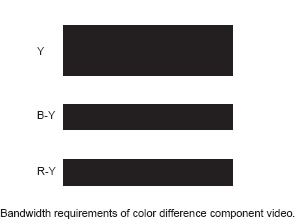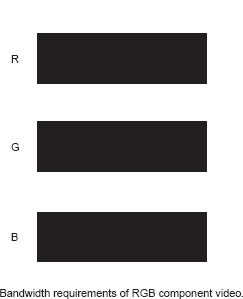Color Difference Component Video
If you are in a studio setting where you can use individual cables for each of the red, green, and blue channels, you don't have to worry very much about how much bandwidth they use. If, however, you have to send a color signal through the air or several video signals through one cable, bandwidth can become a problem. To save bandwidth, engineers developed color difference component video. This system still uses three different signals to carry the complete picture, but the engineers came up with a method that eliminates the redundancy found in the RGB channels. First is the Y channel, which is all of the luminance channel. We learned earlier that the green channel makes up 59% of the total color signal, so most of the luminance information comes from the green channel. But the red and blue channels also have luminance information. Since we already have that in the Y channel, we don't need the parts of it that are in the red and blue channels. So it is subtracted from those two channels, leaving red minus luminance (R-Y) and blue minus luminance (B-Y). This gives us pure red information and pure blue information and luminance information.When the picture is reassembled, the necessary luminance information is taken from the Y channel and added to blue and red. Anything left in the Y channel has to be for the green channel, and the picture is thus reconstructed. Using the Y (R-Y) (B-Y) color difference system saves a tremendous amount of bandwidth while keeping all of the advantages of high-quality component video.
The Y/C, RGB, and color difference systems are all different types of component video. Most systems that are set up for RGB can also use the color difference system.


